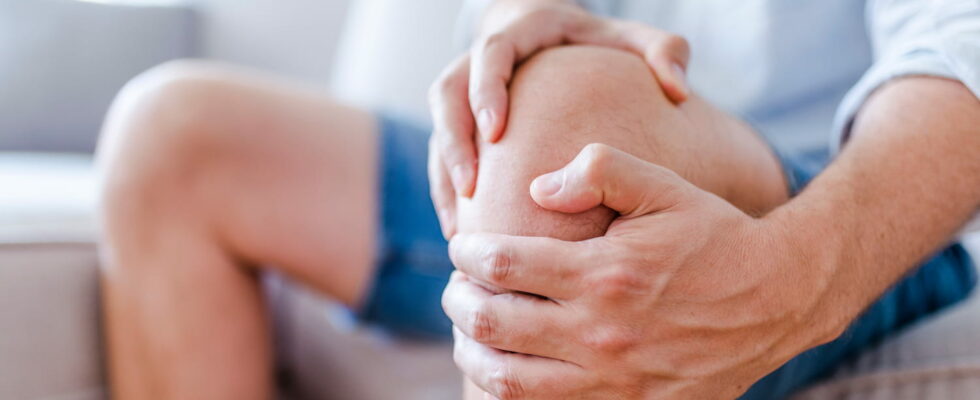Osteoarthritis of the knee (gonarthrosis) is more and more common as we age, but it is painful.
Gonarthrosis is osteoarthritis that affects the knee. It would concern 30% of 65-75 year olds. It is a disabling osteoarthritis because it affects a large joint supporting the weight of the body. This disease can cause major disability for patients. More than 90,000 knee prostheses are installed each year in France because of osteoarthritis. Its prevalence increases in women at the time of menopause. Gonarthrosis is bilateral (both knees affected) in 75% of cases.
As a reminder, osteoarthritis results in premature wear of the cartilage, the gelatinous structure which lines the bone ends allowing them to slide over each other without friction. In cases of osteoarthritis, the cartilage thins and cracks. The destruction of the cartilage can extend to the remains of the joint, i.e. the bones but also the synovial membrane which lubricates the joint, causing pain.
What are the causes of knee osteoarthritis?
► Aging: while 3% of those under 45 are affected by osteoarthritis, around 65% of those aged 65 and over suffer from it and after 80, more than 80%.
► Genetics: scientific literature suggests that people are genetically predisposed to knee osteoarthritis.
► Trauma: osteoarthritis of the knee would be observed more in patients who have had a poorly treated sprain, removal of the meniscus, etc.
► Excess weight: “Excess weight is an important factor because it overstresses the joint. A moderate loss of a few kilos can improve, or even prevent, the onset of this joint disease.“, tells us Professor Aleth Perdriger, head of the rheumatology department at Rennes University Hospital.
► Carrying heavy loads at work increases mechanical stress and damages the knee cartilage.
► The intensive practice of certain sports is also singled out (football, rugby, skiing, etc.).
Osteoarthritis of the knee (left, normal joint, right, joint with osteoarthritis)
What are the symptoms of knee osteoarthritis?
Osteoarthritis may go unnoticed and be discovered incidentally during imaging studies. When it manifests, it causes mechanical pain (induced by movement), which will gradually prevent the patient from walking, climbing stairs, etc. Painful flare-ups may occur. They are generally associated with swelling and stiffness of the joint. Over the years, deformation of the joint may appear.
Diagnosis: radio or ultrasound?
Symptoms of osteoarthritis of the knee may be enough to diagnose osteoarthritis. But the doctor can confirm the diagnosis thanks to an x-ray examination which allows visualization of joint pinching, bone growths around the joint (called osteophytes) or localized rarefactions of bone (called geodes). It may be useful to carry out this radiological examination regularly to monitor the progression of the disease and decide on possible surgical treatment. Ultrasounds, MRI or CT scans are useless tests for diagnosing osteoarthritis. Likewise, there is no blood marker to establish the diagnosis.
What are the treatments to treat osteoarthritis of the knee?
There is no cure, only symptomatic treatments aimed at relieving pain are available. “The treatment of osteoarthritic crisis is based on analgesics. In the event of inflammatory flare-ups, non-steroidal anti-inflammatory drugs (NSAIDs) are useful. Local infiltrations of corticosteroids can also be done.“, describes Professor Aleth Perdriger. Hyaluronic acid injections (visco-supplementation) can be offered to patients (not reimbursed by social security).
Physiotherapy?
Rehabilitation sessions with a physiotherapist are strongly recommended to maintain the flexibility and stability of the joint. The exercises performed strengthen the quadriceps and allow the range of motion of the joint. During a surgical procedure, pre-operative rehabilitation is considered before the operation.
What sport when you have knee osteoarthritis?
Gentle physical activity is recommended for the joint such as swimming, walking or cycling, apart from inflammatory flare-ups. The activity helps strengthen the leg muscles. It also helps overweight people lose the few extra pounds that weigh on their joints: benefits are visible from 5 pounds lost.
Knee brace, splint…
A knee brace or splint can relieve the joint by improving the sensations of knee positioning. Wearing orthopedic insoles can relieve pressure on the painful compartment, correct a foot posture defect or absorb some of the shock waves. Using a cane held in the hand on the side opposite the affected knee can help relieve the knee joint.
When to operate on the knee?
If, despite treatment and rehabilitation, pain persists and a disability sets in, the doctor may suggest surgical intervention and the installation of a total or partial prosthesis to replace the joint. Arthroscopic surgery does not require opening the knee joint. The surgeon makes two small incisions of approximately 3 mm in order to insert a fiber optic camera connected to a camera into the knee, allowing all of the structures of the knee joint to be visualized. On the other hand, a prosthesis is indicated when there is significant wear of the cartilage, most often caused by osteoarthritis or rheumatoid arthritis. The procedure, performed under general or local anesthesia, lasts between 1.5 and 2 hours. Knee rehabilitation sessions are necessary for approximately two months.
If the osteoarthritis is linked to a deformation of the joint, the surgeon can straighten the tibia or femur, while preserving the joint. This is called osteotomy, a technique which involves cutting the bone and straightening it and then maintaining this modification. This helps align the lower limb and rebalance the pressures placed on the knee. This surgery is particularly intended for patients with genu valgum (knees inwards). This procedure relieves pain and stabilizes osteoarthritis. Finally, total knee arthroplasty involves replacing disabled parts of the knee with artificial implants that allow flexion and extension of the knee as well as improvement in walking and walking range. The indication for knee arthroplasty depends on pain, functional discomfort and reduced quality of life.
Thanks to Professor Aleth Perdriger, head of the rheumatology department at Rennes University Hospital, for his details and validation.
